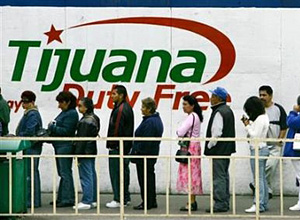 |
 |
 |
 News from Around the Americas | April 2007 News from Around the Americas | April 2007  
Massive Traffic Cripples Tijuana Border Crossing
 Robin Emmott - Reuters Robin Emmott - Reuters


| | People wait in line to cross the border between Mexico and the United States in Tijuana, Mexico in this May 6, 2006 file photo. The world's busiest land border crossing between the United States and Mexico is 'saturated' and 'grossly out of date' but it is unclear if Congress will provide the money to overhaul it, a senior U.S. official said. (Carlos Barria/Reuters) |
The world's busiest land border crossing between the United States and Mexico is "saturated" and "grossly out of date" but it is unclear if Congress will provide the money to overhaul it, a senior U.S. official said.

A growing cross-border community of commuters and tougher security to catch illegal immigrants and narcotics smugglers mean drivers now spend up to 2-1/2 hours to cross from the Mexican city of Tijuana into San Diego.

"The San Ysidro facility is grossly out of date and we are typically saturated," Adele Fasano, director of California field operations for U.S. Customs and Border Protection, told Reuters in a interview this week.

"We have the added complication of catching the bad guys. It is like searching for a needle in a haystack," she added, overlooking the long lines of cars waiting to cross into the United States from Tijuana.

California's other six border crossings, which also handle trucks and which were mostly built in the 1970s, face severe congestion. The proposed $550 million San Ysidro upgrade is not likely to be completed until 2014.

Plans to build another entry point near San Ysidro are also struggling to win financing from the state and federal government due to the high cost, said Fasano.

Some 90 million people a year use the California-Mexico land border crossings, with almost half the traffic going through San Ysidro alone. Tijuana's population, especially its middle class, is growing fast and U.S. residents are attracted to the city because of lower Mexican property prices.

"We are trying to be as efficient and creative as we can but we are a major smuggling corridor, a high volume port for violations," Fasano said.

The long lines of traffic - which even for pedestrians can tail back for miles (kms) - prompt many Mexicans and Americans living in Tijuana and working in San Diego to try to get to the port at around 4 a.m. to avoid the delays and get to work on time.

"The San Ysidro plan is to totally rebuild the port, extend the lanes and shift southbound traffic to a currently abandoned truck facility. But we do not have the budget yet from Congress," Fasano said.

"We are also looking at building a new border crossing east of the Otay Mesa port of entry, called Otay II, but nothing is decided yet, we're talking to the state about financing," she added.

The Otay II project could envisage charging a user fee to help pay for the new border crossing, Fasano said.

In the meantime, California officials hope a requirement for U.S. citizens to show identification when crossing the border from 2009 and plans to vet more commuters to increase the use of high-speed "Sentri" lanes should ease congestion. | 
 | |
 |



